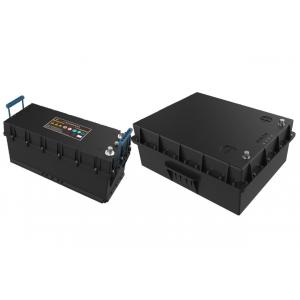

Add to Cart
Long Service Life 24V Lithium-ion Heavy Truck Dual Purpose Replacement Battery
The trucks are always on the road, so it has the high requirements for the battery. Especially for the dual purpose battery, it needs the large cranking power and long power supply for the electric appliances during parking time. The service life of this lithium-ion battery is much longer than normal lead-acid battery, and it can provide longer power supply hours for the electric appliances. The lithium-ion battery can adapt to the ultra-low temperature, and you can quickly start the truck even under -40 ℃. What's more, the lithium-ion battery is much lighter than lead-acid battery, so that it can save the fuel consumption of the truck. And thanks to the strong R&D ability and many years' experience in car batteries, the performance of this battery achieves better scores by comparing with most of the batteries.
Product Features
Longer Service Life
100% DOD is more than 2000 times, to ensure 5 years’ service life
Over-Discharge Protection
BMS intelligent management keeps 20% of the minimum starting power
to ensure easy start
Fast Recharging
Superior charging acceptance, fast recharging in 2 hours to reach
95% SOC
Light Weight
2/3 lighter than lead-acid battery, more fuel efficient and
environmental friendly
Excellent Cold Cranking Performance
Instant cranking under ultra-low temperature(-40 ℃), no need to
warm up
Strong Vibration Resistance
5G vibration resistance, adaptable for rough road conditions
Online Monitoring
View the battery status online in real time, to check the battery
voltage, temperature, health status.
Strong Power Supply for Electric Appliances
Power supply for electric appliances such as air conditioner during
parking period for 9+ hours, enjoy a more comfortable driving
environment
Product Model
| Type | Voltage (V) | Capacity (Ah) | Dimensions(mm) L*W*H | CCA(-18℃)(A) | Weight(kg) |
| 24V LiSB CCA1100 | 24 | 200 | 530*433*220 | 1100 | ≤55 |
Applications
This lithium-ion heavy truck dual purpose replacement battery is the best choice for the heavy vehicles to achieve the most profit.
About Camel
Founded in 1980, Camel Group Co., Ltd.(Stock No: SH601311) is
specialized in the R&D, production and sales of lead-acid
batteries, with the production of EV lithium-ion battery and used
battery recycling as the supplement. Camel is the largest and
leading car battery manufacturer in Asia.
Currently, Camel has four major brands, which are CAMEL, HUAZHONG,
SWAN, DF. With over 400 types of products covering automotive
starter battery, start-stop battery, lithium-ion battery, traction
battery, etc. Camel batteries are widely used in cars, trucks,
agricultural vehicles, golf carts, electric vehicles and other
applications.
The core competitiveness of Camel Group stems from continuous
independent innovation, clear development strategy and efficient
execution, which are all based on having an enterprising and
innovative management and technical team. To ensure the
technological leadership in the industry, Camel has continuously
increased R&D investment and introduced the world's leading
automatic production lines, and advanced R&D and testing
devices. The professional R&D institute under the company is
recognized as state-level enterprise technology center. Camel also
has academician expert workstation and state-level laboratory. As a
high-tech enterprise supported by the state, Camel has entered the
field of new energy vehicle prospectively, committed to green
energy manufacturing and recycling, and opening a low-carbon life
for mankind.
FAQ
1. Why is there a possible battery explosion? And how do we prevent
it?
A: A lot of hydrogen and oxygen will be produced during the charging process of battery. When the concentration of the mixed gas reaches 4% in the air, if sparks generated due to loose wire connection or open fire from outside interferes, there is a possibility that explosion may occur, which will damage the battery or even injure people and things. Preventions are as below:
a. Control the power charged, avoid overcharge, to reduce the amount of gas degassed.
b. No open fire near the batteries during charging process and keep good ventilation.
c. During charging, the connection should be firm to avoid sparks due to loose connection.
d. Adopts constant current and limited voltage charging method, which generates less gas evolution.
e. Prevent sparks or even fire and explosion due to short circuit.
f. Keep the degassing hole unobstructed for the maintenance-free sealed batteries, otherwise, the increased internal pressure may accumulate too high to cause bulge or even explosion.
2. Why the capacity is decreased?
A: If battery shows insufficient capacity during usage, or capacity cannot meet rated capacity value, we should firstly consider the possibility of insufficient charge or insufficient recharge after usage. Check if the electrolyte density is too low, of if the electrolyte level increases after recharge.
a. Sulfation (over-charge, repeated charge, hydrotherapy for desulfurization)
b. Pollution of electrolyte (after multiple flushing with distilled water, change the electrolyte)
c. Whether batteries show partial short circuit.
d. Phenomena like grid corrosion, plate breakage, active mass shedding etc. at the end of service life.
